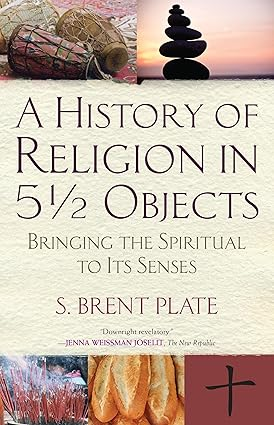S. Brent Plate, A History of Religion in 5 1/2 Objects: Bringing the Spiritual to its Senses, Beacon Press, 2014.
I am not sure that this is a "history" of religion, not in a traditional sense. It is an account of religion that begins with the sensuous encounter of human bodies with the world, with objects in the world. "Religion," he writes must be understood as deriving from rudimentary human experiences, from lived embodied practices" (15). It was brought to my attention that this is affect theory. And while I don't have a background in it and Plate doesn't cite affect theory in his introduction, he does reference Paul Stoller, Sensuous Scholarship. Affect theory makes sense😏because Plate's point is not just about objects, but about how the "sensing body" encounters them. He privileges these experiences, "we see, hear, smell, taste, and touch well before we speak" (21). Not only do we encounter objects, but they encounter us, "objects, things, stuff, belongings, mementos, goods, and artifacts all have the ability to speak, to call out, to meet the human body in particular times and places and alter the course of our lives" (13).
Our encounters with objects and the feelings and experiences that result must be communicated through words - so he writes that we must use language "to build upon and make intelligible to others, the physical experiences of our sensual body" (19). Religious experience and religious, i.e, metaphorical, language arises from these encounters with objects and the need to think and communicate about them. These two modes of experiencing in the body and communicating through language (describing, explaining, building upon, theorizing, worshiping) are intertwined in the history or development of religion.
After the introductory "1/2" chapter, Plate dedicates a chapter each to the exploration of five objects, or actually categories of objects that have lent themselves to religious experience: stones, incense, drums, crosses, and bread. Each chapter is a survey of the human/object interaction across time, geography, culture, and religion. The approach is helpful in broadening our thinking about these objects. For example, if and when I bring up crosses in my classroom, my students would immediately and only, rigidly, think about Christianity. But Plate doesn't start there. Instead he begins with minimalism, the artistic movement of Piet Mondrian and Agnes Martin, and the stark image of crossing lines. The encounter with crossed lines has led to much religious innovation. Plate writes, "The image of the cross as the meeting of two lines, situated, suspended, or otherwise located between the heavens and the earth, between life and death, between masculine and feminine, between infancy and adulthood, weaves its way across ancient and modern traditions," (144). This is adjacent enough to the students' immediate frame of reference (and mine as well) to disorient their assumptions, opening a space of reconsideration and learning.
 |
| The Oneida Stone, photo circa 1900 |
Along those lines, Plate also connects each discussion to important religious scholars (like the mention of Paul Stoller, noted above.) In her review of the book on the Religion in American History blog, Samira Mehta notes "Plate’s excellent and very clear use of a range of major figures in religious studies, from classic voices like Emile Durkheim and Max Muller, to contemporary theorists like Sherry Ornter, and to leading scholars like Diana Eck. Each time he does, he gives students a window into the role of theory and scholarship in interpretation." Plate effectively hones in on certain ideas of these thinkers in ways that provide a helpful entry point for further study. Again, this aspect of the book is a bonus for using this book or a chapter of the book in undergraduate courses.
I enjoyed reading A History of Religion in 5 1/2 Objects and found it to be a well-written and very thoughtful introduction to the study of material culture in religion. It takes the reader in unexpected and intriguing directions and stretches our imaginations across a wide variety of religious phenomena.





No comments:
Post a Comment